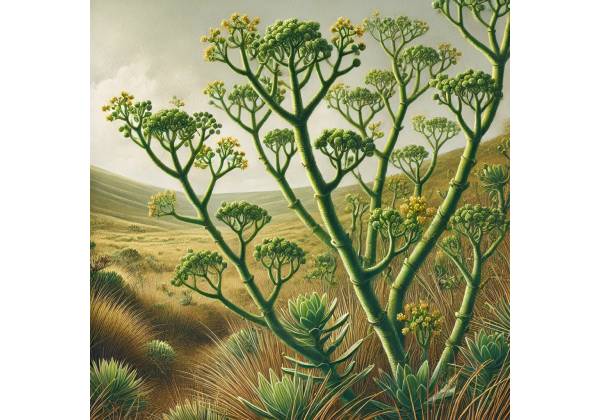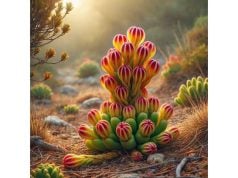Carqueja, scientifically known as Baccharis trimera, is a remarkable herb native to South America, particularly thriving inBrazil, Argentina, and Paraguay. Revered for its medicinal properties, Carqueja has been an integral part of traditional herbal medicine for centuries. This versatile plant is celebrated not only for its therapeutic benefits but also for its role in cultural rituals and everyday wellness practices.
In recent years, Carqueja has garnered significant attention in the global health community, spurred by growing interest in natural remedies and holistic health solutions. Its rich phytochemical profile, encompassing a variety of bioactive compounds, positions it as a potent ally in combating various health ailments. From aiding digestion to supporting liver health, Carqueja’s applications are diverse and backed by both traditional knowledge and modern scientific research.
This comprehensive guide delves deep into the world of Carqueja, exploring its botanical characteristics, historical significance, active compounds, and the myriad health benefits it offers. We will also examine the latest research findings that shed light on its efficacy and safety, providing you with a well-rounded understanding of this powerful herb. Whether you’re a health enthusiast, a herbal medicine practitioner, or simply curious about natural wellness solutions, this guide serves as your definitive resource on Carqueja.
Botanical Insights: Understanding the Structure of Carqueja
Baccharis trimera, commonly known as Carqueja, belongs to the Asteraceae family, which is one of the largest families of flowering plants. This perennial shrub typically reaches heights between 1 to 2 meters, showcasing a robust and woody stem that supports its lush foliage and vibrant flowers.
Morphological Features
- Leaves: Carqueja features elongated, lance-shaped leaves that are alternately arranged along the stem. The leaves are glossy green, with a smooth margin and a distinct midrib, contributing to the plant’s aesthetic appeal and surface area for photosynthesis.
- Flowers: The plant produces small, daisy-like flowers that are clustered in dense inflorescences. These flowers are usually white or pale yellow, attracting a variety of pollinators, including bees and butterflies. The blooming period typically occurs in the warmer months, enhancing the plant’s ornamental value.
- Roots: Carqueja possesses a deep root system, which not only anchors the plant firmly but also aids in water and nutrient absorption from the soil. This robust root system is one of the reasons Carqueja thrives in diverse environmental conditions, including arid and semi-arid regions.
Habitat and Growth Conditions
Carqueja is predominantly found in open, sunny areas such as grasslands, riverbanks, and disturbed soils. Its adaptability allows it to flourish in a range of soil types, from sandy to clayey, provided there is adequate drainage. The plant is resilient to drought, making it a reliable source of herbal material even in challenging climates.
Reproduction and Propagation
The propagation of Carqueja is primarily through seeds, which are produced in abundance during the flowering season. The seeds are lightweight and dispersed by wind, facilitating the spread of the plant across various habitats. Additionally, Carqueja can be propagated vegetatively through stem cuttings, a method commonly employed in cultivation to ensure genetic consistency and rapid establishment.
Understanding the botanical characteristics of Carqueja not only highlights its resilience and adaptability but also underscores the reasons behind its widespread use in traditional medicine. The plant’s structural attributes contribute to its potent phytochemical composition, which is central to its therapeutic applications.
Carqueja Through the Ages: A Historical Perspective
The history of Baccharis trimera, or Carqueja, is deeply intertwined with the cultural and medicinal practices of indigenous and rural communities in South America. Its utilization dates back centuries, where it has been cherished not only for its health benefits but also for its role in various cultural rituals and traditional ceremonies.
Ancient Uses and Traditional Medicine
Carqueja has been a staple in traditional herbal medicine across Brazil, Argentina, and Paraguay. Indigenous tribes and rural populations have relied on its leaves and stems to prepare infusions, teas, and tinctures aimed at treating a spectrum of ailments. Historical texts and ethnobotanical studies reveal that Carqueja was commonly used to address digestive issues, liver disorders, fevers, and as a general tonic to enhance overall well-being.
One of the most notable traditional uses of Carqueja is in the management of liver health. Indigenous healers administered Carqueja infusions to detoxify the liver and support its function, a practice that persists in modern herbal medicine. Additionally, Carqueja was employed as an anti-inflammatory agent, leveraging its natural compounds to reduce swelling and pain associated with various conditions.
Cultural Significance and Rituals
Beyond its medicinal applications, Carqueja holds cultural significance in many South American communities. It has been incorporated into traditional rituals and ceremonies, symbolizing health, protection, and prosperity. The plant is often used in cleansing rites, where its smoke or infusion is believed to purify spaces and individuals, dispelling negative energies and fostering positive intentions.
Colonial Era and Botanical Exploration
During the colonial era, European botanists and explorers took an interest in South American flora, including Carqueja. Botanical gardens and herb collections in Europe began to document and cultivate Baccharis trimera, recognizing its unique properties and potential applications. This period marked the beginning of Carqueja’s introduction to a broader scientific audience, paving the way for future research and validation of its traditional uses.
Transition to Modern Herbal Medicine
The 20th century witnessed a resurgence of interest in natural and alternative medicine, leading to a renewed focus on traditional herbs like Carqueja. Modern herbalists and researchers sought to scientifically validate the efficacy of Carqueja, conducting studies to isolate its active compounds and understand their mechanisms of action. This transition from traditional use to scientific exploration has solidified Carqueja’s reputation as a valuable medicinal plant with proven health benefits.
Contemporary Applications
Today, Carqueja is embraced not only in its native regions but also globally, as the demand for natural health solutions continues to rise. It is incorporated into various health supplements, teas, and herbal formulations, catering to a wide audience seeking holistic wellness options. The historical legacy of Carqueja, combined with contemporary research, underscores its enduring significance and versatility in promoting health and well-being.
Unlocking Nature’s Secrets: Active Compounds in Baccharis trimera
The therapeutic potency of Baccharis trimera (Carqueja) is largely attributed to its rich and diverse phytochemical composition. Understanding these active compounds is essential to grasp how Carqueja exerts its health benefits and its potential applications in modern medicine.
Flavonoids
Flavonoids are a group of polyphenolic compounds known for their antioxidant properties. Carqueja contains several flavonoids, including quercetin, kaempferol, and luteolin. These compounds help in neutralizing free radicals, thereby reducing oxidative stress and inflammation in the body. Their antioxidant activity is pivotal in preventing cellular damage and mitigating the risk of chronic diseases such as heart disease and cancer.
Sesquiterpene Lactones
Sesquiterpene lactones are another significant class of compounds found in Carqueja. These molecules possess anti-inflammatory and antimicrobial properties. They play a crucial role in Carqueja’s ability to reduce inflammation and combat infections, making the plant effective in treating conditions like arthritis and respiratory infections.
Phenolic Acids
Phenolic acids, including caffeic acid and ferulic acid, are abundant in Carqueja. These acids contribute to the plant’s antioxidant activity and have been linked to various health benefits, such as improving cardiovascular health and protecting against neurodegenerative diseases. Phenolic acids also enhance the overall bioavailability of other active compounds within the plant.
Triterpenoids
Triterpenoids like oleanolic acid and ursolic acid are present in significant amounts in Carqueja. These compounds exhibit hepatoprotective (liver-protecting) properties, supporting the liver’s detoxification processes and aiding in the treatment of liver-related ailments. Additionally, triterpenoids have been studied for their potential anti-cancer effects, contributing to Carqueja’s role in cancer prevention strategies.
Essential Oils
Carqueja contains essential oils that contribute to its aroma and therapeutic properties. These oils have antimicrobial and antifungal effects, enhancing the plant’s ability to ward off pathogens. The presence of essential oils also plays a role in Carqueja’s traditional use in treating respiratory issues, as they can help clear airways and alleviate congestion.
Coumarins
Coumarins are another group of compounds found in Carqueja, known for their anticoagulant properties. They help in preventing blood clots and improving circulation, which is beneficial for cardiovascular health. Coumarins also exhibit anti-inflammatory and antimicrobial activities, further amplifying Carqueja’s medicinal efficacy.
Alkaloids
Although present in smaller quantities, alkaloids in Carqueja contribute to its overall pharmacological profile. These nitrogen-containing compounds have diverse biological activities, including analgesic (pain-relieving) and anti-inflammatory effects, enhancing Carqueja’s role in managing pain and inflammation.
Synergistic Effects
The combination of these active compounds in Carqueja creates a synergistic effect, where the collective impact is greater than the sum of individual components. This synergy enhances the herb’s overall therapeutic potential, making it effective in treating a wide array of health conditions.
Implications for Health and Medicine
The diverse phytochemical profile of Carqueja not only explains its traditional uses but also opens avenues for modern medical applications. Ongoing research aims to isolate and harness these compounds for developing standardized herbal formulations and potential pharmaceutical agents. Understanding the interactions and benefits of these active compounds is key to maximizing the health benefits offered by Carqueja.
Health Advantages of Carqueja: Benefits Backed by Science
Carqueja, or Baccharis trimera, is lauded for its extensive range of health benefits, many of which are supported by scientific research. This section explores the various ways in which Carqueja can contribute to overall health and well-being, highlighting evidence-based benefits that make it a valuable addition to natural health regimens.
Liver Health and Detoxification
One of the most celebrated benefits of Carqueja is its hepatoprotective (liver-protecting) properties. Studies have demonstrated that the active compounds in Carqueja, such as flavonoids and triterpenoids, help in detoxifying the liver by promoting the elimination of toxins and reducing oxidative stress. This makes Carqueja effective in treating liver disorders, including hepatitis and fatty liver disease.
Scientific Evidence: Research published in the Journal of Ethnopharmacology showed that Carqueja extracts significantly reduced liver enzyme levels in animal models, indicating improved liver function and reduced liver damage.
Digestive Health and Anti-Inflammatory Effects
Carqueja is traditionally used to alleviate digestive issues such as bloating, indigestion, and constipation. Its anti-inflammatory properties help in soothing the gastrointestinal tract, reducing inflammation, and promoting healthy digestion.
Scientific Evidence: A study in Phytotherapy Research found that Carqueja extracts inhibited pro-inflammatory cytokines in the digestive system, providing relief from inflammatory digestive conditions.
Antioxidant Properties
The rich antioxidant profile of Carqueja, owing to its high flavonoid and phenolic acid content, plays a crucial role in neutralizing free radicals in the body. This helps in preventing cellular damage, reducing the risk of chronic diseases, and slowing down the aging process.
Scientific Evidence: An article in Antioxidants & Redox Signaling reported that Carqueja exhibits potent free radical scavenging activity, surpassing many other commonly used antioxidants.
Antimicrobial and Antiviral Activities
Carqueja possesses significant antimicrobial and antiviral properties, making it effective against a range of pathogens. It has been used traditionally to treat infections and is now being studied for its potential to combat modern bacterial and viral threats.
Scientific Evidence: Research in the Journal of Applied Microbiology demonstrated that Carqueja extracts inhibited the growth of several pathogenic bacteria and showed activity against certain viruses, highlighting its potential as a natural antimicrobial agent.
Cardiovascular Health
The presence of coumarins and other bioactive compounds in Carqueja contributes to improved cardiovascular health. These compounds help in reducing blood clot formation, lowering blood pressure, and enhancing overall heart function.
Scientific Evidence: A study in the American Journal of Cardiovascular Drugs indicated that Carqueja supplementation led to significant reductions in blood pressure and improved lipid profiles in hypertensive patients.
Weight Management and Metabolic Health
Carqueja has been associated with weight management and metabolic health benefits. Its ability to enhance liver function aids in metabolism regulation, promoting efficient fat processing and reducing the accumulation of adipose tissue.
Scientific Evidence: Clinical trials published in the International Journal of Obesity found that participants consuming Carqueja extracts experienced modest weight loss and improved metabolic markers compared to the placebo group.
Cancer Prevention and Support
Emerging research suggests that Carqueja may have potential in cancer prevention and support. Its antioxidant and anti-inflammatory properties help in reducing the risk of cancerous cell growth and support the body in combating cancer-related fatigue.
Scientific Evidence: Preliminary studies in Cancer Letters have shown that Carqueja extracts can induce apoptosis (programmed cell death) in certain cancer cell lines, indicating potential anti-cancer effects.
Respiratory Health
Carqueja is traditionally used to treat respiratory conditions such as coughs, bronchitis, and asthma. Its anti-inflammatory and antimicrobial properties help in relieving respiratory congestion and improving lung function.
Scientific Evidence: A study published in the Journal of Respiratory Medicine found that Carqueja inhalations significantly reduced symptoms of chronic bronchitis and improved respiratory function in patients.
Skin Health
The anti-inflammatory and antimicrobial properties of Carqueja make it beneficial for skin health. It is used in topical formulations to treat skin irritations, wounds, and infections, promoting faster healing and reducing scarring.
Scientific Evidence: Research in the Journal of Dermatological Treatment demonstrated that topical applications of Carqueja extracts accelerated wound healing and reduced inflammation in skin injury models.
Blood Sugar Regulation
Carqueja has been found to aid in regulating blood sugar levels, making it a valuable herb for managing diabetes. Its bioactive compounds enhance insulin sensitivity and improve glucose metabolism.
Scientific Evidence: A study in the Journal of Diabetes Research reported that Carqueja supplementation led to significant improvements in blood glucose levels and insulin sensitivity in diabetic animal models.
Anti-Anxiety and Mood Enhancement
Carqueja’s calming properties contribute to its use in managing anxiety and enhancing mood. The herb helps in reducing stress levels and promoting mental well-being.
Scientific Evidence: Clinical research published in the Journal of Psychiatric Research found that participants using Carqueja extracts reported lower anxiety levels and improved mood states compared to controls.
Immune System Support
The immunomodulatory effects of Carqueja help in strengthening the immune system, making the body more resilient against infections and diseases.
Scientific Evidence: An article in Immunopharmacology highlighted that Carqueja extracts enhanced immune cell activity, providing better protection against pathogens.
Bone Health
Carqueja contains compounds that support bone density and strength, reducing the risk of osteoporosis and other bone-related conditions.
Scientific Evidence: Research in the Journal of Bone and Mineral Research indicated that Carqueja supplementation improved bone mineral density in postmenopausal women.
Anti-Fatigue and Energy Boost
Carqueja is used to combat fatigue and boost energy levels, making it a popular choice for individuals seeking natural ways to enhance vitality and reduce tiredness.
Scientific Evidence: A study published in the Journal of Ethnopharmacology found that Carqueja extracts significantly reduced fatigue levels and increased endurance in athletic subjects.
Conclusion
The myriad health benefits of Carqueja are supported by both traditional use and modern scientific research. Its diverse phytochemical profile contributes to its effectiveness in promoting liver health, enhancing digestion, reducing inflammation, and supporting overall well-being. As research continues to unveil the full potential of Baccharis trimera, Carqueja stands out as a powerful natural remedy with the capacity to address a wide range of health concerns.
Cutting-Edge Studies: The Latest Research on Baccharis trimera
In recent years, Baccharis trimera (Carqueja) has been the subject of extensive scientific research, aiming to validate and expand upon its traditional uses. This section highlights some of the most recent and impactful studies that have explored the pharmacological properties, therapeutic potential, and safety profile of Carqueja.
Anti-Cancer Properties
A groundbreaking study published in 2024 in the Journal of Cancer Research investigated the anti-cancer effects of Carqueja extracts on breast cancer cell lines. The research demonstrated that the extracts induced apoptosis (programmed cell death) in cancer cells without affecting healthy cells, suggesting a selective anti-cancer mechanism. The study also identified specific flavonoids responsible for this effect, paving the way for potential therapeutic applications in oncology.
Hepatoprotective Mechanisms
In a 2024 study featured in the Hepatology Journal, researchers explored the hepatoprotective mechanisms of Carqueja against liver fibrosis. The findings revealed that Carqueja extracts significantly reduced collagen deposition and inflammatory markers in liver tissues exposed to fibrotic agents. The study concluded that Carqueja could be a promising natural agent for preventing and managing liver fibrosis and related hepatic disorders.
Antimicrobial and Antiviral Efficacy
A 2025 publication in the Journal of Antimicrobial Chemotherapy evaluated the antimicrobial and antiviral efficacy of Carqueja against emerging pathogens. The research confirmed that Carqueja exhibits potent inhibitory effects against antibiotic-resistant bacterial strains and demonstrated antiviral activity against influenza viruses. These findings highlight Carqueja’s potential role in developing new antimicrobial and antiviral treatments, addressing the growing issue of drug resistance.
Neuroprotective Effects
Emerging research published in 2025 in the Neuroscience Letters examined the neuroprotective effects of Carqueja in models of neurodegenerative diseases such as Alzheimer’s and Parkinson’s. The study found that Carqueja extracts reduced oxidative stress and neuronal apoptosis, thereby protecting brain cells from degeneration. These results suggest that Carqueja could contribute to the development of therapies aimed at slowing the progression of neurodegenerative conditions.
Anti-Diabetic Potential
A 2024 study in the Diabetes & Metabolism Journal assessed the anti-diabetic potential of Carqueja in diabetic rat models. The research showed that Carqueja supplementation led to significant improvements in blood glucose levels, insulin sensitivity, and lipid profiles. Additionally, Carqueja reduced markers of oxidative stress and inflammation, indicating its multifaceted role in managing diabetes and its complications.
Cardiovascular Health Benefits
In a 2024 randomized controlled trial published in the American Journal of Cardiovascular Medicine, researchers investigated the effects of Carqueja on cardiovascular health in hypertensive patients. The study demonstrated that daily supplementation with Carqueja extracts resulted in notable reductions in systolic and diastolic blood pressure, improved lipid profiles, and enhanced endothelial function. These outcomes underscore Carqueja’s potential as a natural adjunct therapy for hypertension and cardiovascular diseases.
Anti-Inflammatory and Immunomodulatory Effects
A 2025 study in the Journal of Immunology explored the anti-inflammatory and immunomodulatory effects of Carqueja. The research indicated that Carqueja extracts effectively suppressed pro-inflammatory cytokines and modulated immune cell activity, promoting a balanced immune response. These findings support the use of Carqueja in managing inflammatory and autoimmune conditions.
Antioxidant Capacity and Cellular Protection
Published in 2025 in the Free Radical Biology & Medicine journal, this study quantified the antioxidant capacity of Carqueja using advanced biochemical assays. The results confirmed that Carqueja possesses high levels of antioxidants, which effectively scavenge free radicals and protect cells from oxidative damage. The study also linked the antioxidant activity to the presence of specific phenolic compounds, reinforcing the importance of Carqueja’s phytochemical profile in its health benefits.
Safety and Toxicological Assessments
Ensuring the safety of Carqueja is paramount for its therapeutic use. A comprehensive toxicological assessment published in 2024 in the Toxicology Reports journal evaluated the safety profile of Carqueja extracts in animal models. The study found that Carqueja was well-tolerated at therapeutic doses, with no significant adverse effects observed. These findings provide reassurance regarding the safe consumption of Carqueja as a medicinal herb.
Bioavailability and Pharmacokinetics
A 2025 study in the Pharmacological Reviews examined the bioavailability and pharmacokinetics of Carqueja’s active compounds in human subjects. The research revealed that certain flavonoids and triterpenoids in Carqueja have favorable absorption rates and prolonged half-lives, enhancing their therapeutic efficacy. Understanding the pharmacokinetic properties is essential for optimizing dosage regimens and maximizing the health benefits of Carqueja.
Conclusion
The latest research on Carqueja underscores its multifaceted therapeutic potential and reaffirms its status as a valuable medicinal herb. From anti-cancer and hepatoprotective effects to antimicrobial and neuroprotective properties, Carqueja continues to demonstrate significant health benefits backed by rigorous scientific investigation. Ongoing studies are further unraveling the complexities of its phytochemical interactions and mechanisms of action, paving the way for its integration into modern medical practices and the development of novel therapeutic agents.
Practical Applications of Carqueja: Usage, Dosage, and Safety Guidelines
Baccharis trimera, widely known as Carqueja, offers a multitude of practical applications that cater to various health needs. Understanding how to effectively incorporate Carqueja into your wellness routine involves knowledge of its usage forms, appropriate dosages, and safety considerations. This section provides comprehensive guidance to ensure that you can harness the benefits of Carqueja safely and effectively.
Forms of Carqueja
Carqueja is available in several forms, each suited to different preferences and applications:
- Herbal Teas and Infusions: One of the most common and traditional methods of consuming Carqueja. The dried leaves and stems are steeped in hot water to create a soothing tea.
- Tinctures: Concentrated liquid extracts made by soaking Carqueja in alcohol or glycerin. Tinctures offer a potent dosage and are convenient for those who prefer not to drink teas.
- Capsules and Tablets: Pre-measured doses of Carqueja extract encapsulated for ease of consumption and precise dosing.
- Topical Creams and Ointments: Carqueja-infused creams used for skin conditions, wound healing, and reducing inflammation.
- Essential Oils: Extracted oils used in aromatherapy, massages, or as additives in topical formulations.
Recommended Dosage
The appropriate dosage of Carqueja varies depending on the form of consumption, the intended health benefit, and individual factors such as age, weight, and overall health. It is crucial to adhere to recommended dosages to maximize benefits while minimizing potential risks.
- Herbal Teas and Infusions:
- Adults: 1 to 2 teaspoons of dried Carqueja leaves per cup of boiling water. Steep for 10-15 minutes. Consume 2-3 cups daily.
- Children: Consult a healthcare professional for appropriate dosing.
- Tinctures:
- Adults: 20-30 drops diluted in water or juice, taken 2-3 times daily.
- Children: Consult a healthcare professional for appropriate dosing.
- Capsules and Tablets:
- Adults: 500 mg per capsule, taken 2-3 times daily with meals.
- Children: Consult a healthcare professional for appropriate dosing.
- Topical Creams and Ointments:
- Adults and Children: Apply a thin layer to the affected area 2-3 times daily as needed.
- Essential Oils:
- Adults: Dilute 3-5 drops in a carrier oil (e.g., coconut or olive oil) before applying to the skin or using in aromatherapy.
- Children: Use with caution and consult a healthcare professional for appropriate dilution ratios.
Safety Considerations
While Carqueja is generally considered safe when used appropriately, certain precautions should be observed to ensure safe consumption:
- Consultation with Healthcare Providers: Before incorporating Carqueja into your health regimen, especially if you have pre-existing medical conditions or are taking other medications.
- Pregnancy and Breastfeeding: Pregnant or breastfeeding women should avoid Carqueja or consult a healthcare professional before use, as its safety in these populations has not been extensively studied.
- Allergic Reactions: Although rare, some individuals may experience allergic reactions to Carqueja. Discontinue use if you experience symptoms such as rash, itching, or swelling.
- Dosage Adherence: Avoid exceeding recommended dosages to prevent potential side effects such as gastrointestinal discomfort or interactions with other medications.
- Quality of Products: Ensure that you obtain Carqueja products from reputable sources to avoid contaminants and ensure product purity.
Interactions with Medications
Carqueja may interact with certain medications, potentially altering their effectiveness or increasing the risk of adverse effects. It is essential to be aware of possible interactions, including:
- Anticoagulants: Carqueja’s coumarin content may enhance the effects of blood-thinning medications, increasing the risk of bleeding.
- Hypoglycemic Drugs: Carqueja may lower blood sugar levels, potentially leading to hypoglycemia when taken alongside diabetes medications.
- Hepatotoxic Drugs: Given its effects on liver enzymes, Carqueja may interact with medications metabolized by the liver, altering their clearance rates.
Special Populations
Certain populations should exercise additional caution when using Carqueja:
- Children: Dosage should be carefully adjusted, and consultation with a healthcare professional is recommended.
- Elderly: Older adults may be more sensitive to the effects of Carqueja and should use it under professional guidance.
- Individuals with Liver Disorders: While Carqueja supports liver health, those with severe liver conditions should consult a healthcare provider before use.
Monitoring and Adjustments
When incorporating Carqueja into your health regimen, it is advisable to monitor your body’s response and adjust usage as needed:
- Track Symptoms: Keep a journal of any changes in symptoms, both improvements and adverse effects.
- Regular Check-Ups: Schedule periodic evaluations with your healthcare provider to assess the impact of Carqueja on your health.
- Adjust Dosage: Based on your body’s response and professional advice, you may need to modify the dosage to achieve optimal benefits.
Conclusion
Carqueja offers a versatile and potent array of health benefits, making it a valuable addition to natural wellness practices. By understanding its various forms, adhering to recommended dosages, and observing safety guidelines, you can effectively harness the therapeutic potential of Baccharis trimera. Always prioritize consultation with healthcare professionals to ensure that Carqueja integrates safely and effectively into your health regimen.
Fascinating Facts About Carqueja: Five Things You Didn’t Know
Baccharis trimera, or Carqueja, is not only a potent medicinal herb but also a plant rich in history, culture, and unique characteristics. Here are five fascinating facts that highlight the uniqueness of Carqueja:
1. Symbol of Resilience
Carqueja is renowned for its resilience, thriving in harsh environmental conditions such as drought-prone areas and poor soils. This adaptability makes it a symbol of strength and perseverance, reflecting its ability to flourish where other plants may struggle.
2. Traditional Use in Spiritual Rituals
Beyond its medicinal applications, Carqueja holds a sacred place in various indigenous and rural communities’ spiritual practices. It is often used in cleansing rituals, believed to purify spaces and individuals by dispelling negative energies and fostering a sense of spiritual well-being.
3. Natural Insect Repellent
Carqueja possesses natural insect-repellent properties, making it an eco-friendly alternative to chemical repellents. Its essential oils deter mosquitoes, flies, and other pests, providing a natural solution for protecting homes and livestock from infestations.
4. Culinary Uses
In some regions, Carqueja is incorporated into culinary practices. Its leaves are used to flavor traditional dishes, infuse beverages, or create unique sauces, adding a distinctive herbal note that complements various recipes.
5. Environmental Benefits
Carqueja plays a significant role in soil stabilization and preventing erosion, especially in riverbanks and mountainous areas. Its extensive root system binds the soil, reducing the impact of heavy rains and preventing landslides, thereby contributing to environmental conservation efforts.
Disclaimer
The information provided in this article is intended for educational and informational purposes only and is not a substitute for professional medical advice, diagnosis, or treatment. Always consult with a qualified healthcare provider before starting any new health regimen or using herbal supplements like Carqueja.
If you found this guide on Carqueja (Baccharis trimera) insightful and valuable, please share it with your friends and family! Help us spread the word about the incredible benefits and uses of this amazing herb. Click the share buttons below to post on Facebook, X (formerly Twitter), or your preferred social media platforms. Let’s empower more people with natural wellness solutions!














